1900-1934 - Winning entries - Coins and medals - Timeline and pictures
By Museum Victoria | Thursday, 22 November 2007
As regional and rural communities grew, country people began to showcase their achievements at agricultural shows around the state. The agricultural show was a major social event at which many community competitions took place.
These included Scottish Dancing, for which gold medals were awarded even during the 1930s Depression.
New century plaque, 1900
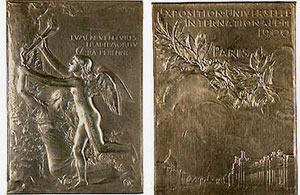
This plaque was sold as a memento at the Paris International Exhibition of 1900. It depicts an exhausted 19th Century collapsed by a tree but still bravely holding the flame high. A youthful 20th Century takes the torch from her hand and her journey begins.
Obverse - The youthful 20th Century takes the flame from an exhausted 19th Century with the legend LVMEN VENTRIVS TRADIT MORITV RA PERENNE [At the time of your death you deliver up the light you have carried that it might continue to burn].
Reverse - Above a victor's garland is the legend EXPOSITION UNIVERSELLE INTERNATIONAL DE 1900 PARIS, below it is a view of a Paris street.
China war medal, 1900
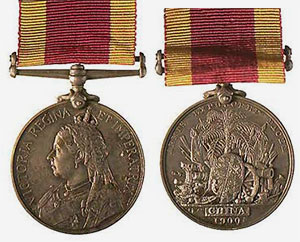
This is a war medal issued for the 1900 Boxer Rebellion in China. The Colony of Victoria sent a naval contingent to China to support the British campaign. This medal was awarded to a member of that force, W Slade. The edge of the medal is impressed W. SLADE, A.B. VICTORIA NAV. CONTGT.
Obverse - Crowned bust of Queen Victoria facing left. Around it in Latin is the legend VICTORIA REGINA ET IMPERATRIX [Victoria Queen and Empress].
Reverse - Depicts a war trophy with the British arms set on a shield resting against a palm. Below is the legend CHINA 1900.
Federation medal, 1901
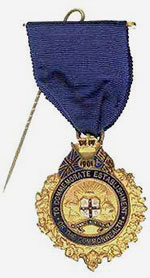
The Federation of the colonies in 1901 to form the Commonwealth of Australia was an occasion for celebration and national pride. Numerous medals were produced, often to be worn at special Federation events. This medal is made from enamelled silver; others were made from gold, copper or tin.
Obverse - The Australian arms are within a crowned wreath, British flags and a shield bearing the date 1901. Around them is the legend TO COMMEMORATE ESTABLISHMENT OF THE COMMONWEALTH.
Edward VII coronation medal, 1902
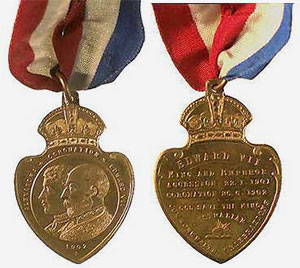
The coronation of Edward VII in 1902 prompted major celebrations in Australia. It was an opportunity for the new nation to reaffirm its pride at being a key member of the British Empire. Over 40 different medals were produced around Australia, this medal, for school children, was made in Melbourne by Stokes.
Obverse - Conjoined busts of King Edward and Queen Alexandra facing left, with the legend EDWARD VII AND ALEXANDRA CROWNED 1902.
Reverse - The legend EDWARD VII KING AND EMPEROR ACCESSION 22.1.1901 CORONATION 9.8.1902 GOD SAVE THE KING AUSTRALIAN COMMONWEALTH CELEBRATIONS.
White Australia medal, about 1906
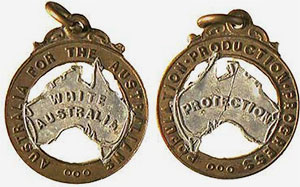
The White Australia policy, which severely restricted entry of non-British immigrants, was a key expression of the new nation's identity. Tariff protection and immigration restrictions were considered essential to the survival of a European nation at the edge of Asia and the Pacific. The medal employed the metal aluminium to visually proclaim that Australia should be white.
Obverse - A map of Australia in aluminium, with the legend WHITE AUSTRALIA. Around this on a brass rim are the words AUSTRALIA FOR THE AUSTRALIANS.
Reverse - The back of the map of Australia with the word PROTECTION. Around this on the brass rim is the legend POPULATION PRODUCTION PROGRESS.
Exhibition of Women's Work exhibition medal, 1907
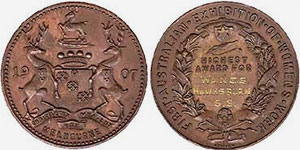
This is a bronze prize medal of the 1907 First Australian Exhibition of Women's Work which was held at the Exhibition Building. It was won by students of Hawksburn State School for an exhibit of wands. This was an important national exhibition that was seen as uniting the new nation through the work of women.
Obverse - A coat of arms with the legend 1907 MELBOURNE.
Reverse - Around a wreath is the legend FIRST AUSTRALIAN EXHIBITION OF WOMEN'S WORK. Within the wreath is AWARDED TO and the engraving WANDS / HAWKSBURN.
Franco-British Exhibition medal, 1908

This is a gold prize medal from the Franco-British Exhibition held in London in 1908. This medal was won by W Glascow of Gippsland, Victoria.
Obverse - A female figure with arm raised stands before the exhibition buildings. Around her is the legend FRANCO BRITISH EXHIBITION. On a plaque is the engraving W. GLASCOW, BENA GIPPSLAND AUSTRALIA. Small letters giving the medal registration number and the name of the artist, F. Bowcher 1908, record the intellectual property claim.
Reverse - France and Britannia seated, with Victory standing behind holding a victor's wreath. Around and above them is the legend LONDON MDCCCCVIII.
Australian florin, 1910
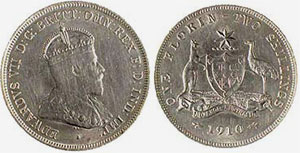
The Commonwealth of Australia first issued its own coins in 1910, nine years after Federation. The coins were made at the Royal Mint, London; Australian coins were first made locally in 1916. This coin was sent from London for the Melbourne Mint's collection.
Obverse - Crowned bust of Edward VII facing left. Around it is the Latin legend EDWARDUS VII D:G: BRITT: OMN: REX: F:D: IND:IMP: [Edward VII by the Grace of God King of the Britons, Defender of the Faith, Emperor of India].
Reverse - At the centre are the Australian arms supported by a kangaroo and an emu, with the legend ADVANCE AUSTRALIA on the ribbon. Around them is the legend ONE FLORIN - TWO SHILLINGS.
8 Hours Committee medal, 1910
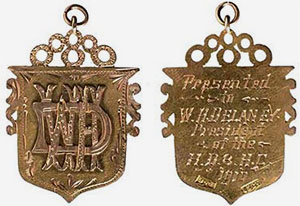
This is a presentation gold medal from an 8 Hours Committee in 1910. It was specially made for W H Delaney whose name is inscribed on the back and whose initials appear as the main design feature of the front.
Obverse - The monogram W H D on a gold shield supported from a loop by the numbers 888.
Reverse - The back is inscribed Presented to W. H. DELANEY of the H. D. 8 H. C. 1910.
Coronation of George V medal, 1911
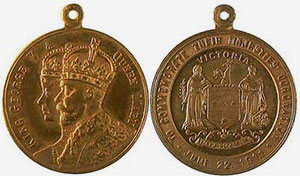
This commemorative medal was distributed to Victorian school children to celebrate the coronation of King George V and Queen Mary in 1911.
Obverse - Conjoined crowned busts of the King and Queen facing left. Around this is the legend KING GEORGE V QUEEN MARY.
Reverse - At the centre the arms of Victoria with the word VICTORIA above. Around this on a broad rim is the legend TO COMMEMORATE THEIR MAJESTIES CORONATION JUNE 22 1911.
Railway commemorative medal, 1914
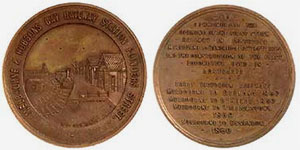
This commemorative medal was designed by the collector Alfred Chitty to mark the 60th anniversary of the opening of Australia's first railway, the Melbourne to Sandridge line in 1854. Chitty had 50 medals struck. He presented this one to the Melbourne Mint.
Obverse - View of an early steam train at the Flinders Street Station in 1854. Around this is the legend MELBOURNE & HOBSONS BAY RAILWAY STATION FLINDERS STREET.
Reverse - The legend TO COMMEMORATE THE OPENING OF THE FIRST STEAM RAILWAY IN AUSTRALIA MELBOURNE TO SANDRIDGE 12TH SEPTR. 1854 AND THE CONSTRUCTION OF THE FIRST LOCOMOTIVE USED IN AUSTRALIA ALSO EARLY VICTORIAN RAILWAYS MELBOURNE TO GEELONG 1857 MELBOURNE TO ST. KILDA 1857 MELBOURNE TO WILLIAMSTOWN 1859 MELBOURNE TO ESSENDON 1860.
ANZAC medal, 1918
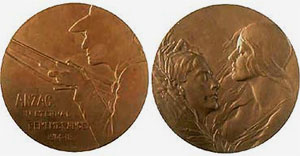
This medal was produced and sold to raise funds for of Australians and New Zealanders maimed in World War One. Artist Dora Ohlfsen features a fallen soldier being comforted by a female 'Australia'.
Obverse - A silhouette of an ANZAC advancing left and holding a rifle with the legend ANZAC. IN ETERNAL REMEMBRANCE 1914-18. (The features of the soldier are based on the brother of the artist).
Reverse - Australia comforts a fallen soldier. The model for Australia was Miss Alix Simpson.
World War One memorial plaque, about 1920
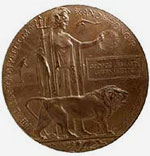
Medals were issued to the family of each member of the British Imperial Forces who died in the First World War. This example commemorates Australian Captain George Jerrard Greenhields.
Obverse - Britannia standing facing right holding an inverted wreath and accompanied by a lion. The wreath is held above a plaque giving the name of the fallen soldier GEORGE JERRARD GREENSHIELDS. Around this is the legend HE DIED FOR FREEDOM AND HONOUR. Below is a British lion killing a German eagle.
School's Peace medal, 1919
This medal distributed to Australian school children to commemorate the signing of the Treaty of Versailles in June 1919 that formally ended of World War One. The medal was designed by Douglas Richardson and distributed by the Department of Defence.
Obverse - An Australian soldier and sailor support a shield, above which is the rising sun and the word VICTORY. The shield bears the legend THE TRIUMPH OF LIBERTY AND JUSTICE THE PEACE OF 1919.
Reverse - Victory standing, arms spread, and with billowing clothing. Below her is the legend PEACE 1919 AUSTRALIA.
Bert Hinkler commemorative medal, 1928
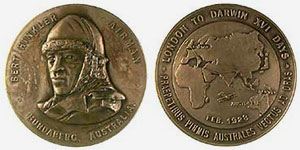
This medal was produced in association with radio station 3LO to support their Melbourne Hospital Birthday Appeal. It was designed by Douglas Richardson and featured the epic flight of Bert Hinkler from England to Australia in 1928.
Obverse - Bust of Hinkler in flight gear, around which is the legend BERT HINKLER AIRMAN BUNDABERG AUSTRALIA.
Reverse - Depiction of the route taken from England to Australia by Hinkler, with the date Feb. 1928 below. Around this is the legend LONDON TO DARWIN XVI DAYS and below in Latin PRAEPETIBUS PINNIS AUSTRALES AD ORAS [borne on swift wings to Australian shores].
Sale Show medal, 1931

This is one of a group of gold and silver medals won at country shows around Victoria by Gladys Bowman in the late 1920s early 1930s for Scottish dancing. This gold medal was won for the Highland Fling at the Sale Show of 1931.
Obverse - A Scotch thistle.
Reverse - The inscription SALE SHOW 1ST. HIGHLAND FLING Under 16 (Dist) Won by GLADYS BOWMAN 28-10-31.
Melbourne Centenary medal, 1934 - 1935
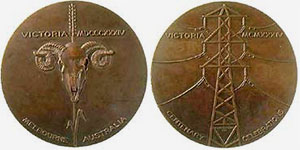
This is the official Melbourne and Victorian Centenary medal. It was struck in silver and bronze to help fund the events surrounding the Centenary celebrations. The designer was the noted artist Raynor Hoff, but the features of a sheep's skull and high voltage power lines proved unpopular. The dies used to strike the medal were defaced and placed in the Museum' collection to ensure that no extra medals could be struck.
Obverse - A sheep's skull in front of an ear of wheat, with the legend VICTORIA MDCCCXXXIV MELBOURNE AUSTRALIA.
Reverse - High voltage power lines strung on a pylon with the legend VICTORIA MDCCCXXXIV CENTENARY CELEBRATIONS.t.
Melbourne Show medal, 1934
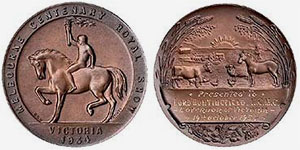
In 1934 the Melbourne Show celebrated the Centenary of Victoria with a series of special events. The Governor of Victoria, Lord Huntingfield KCMG, was awarded this medal in appreciation for his support. Prize winners that year each received a similar medal.
Obverse - Equestrian figure bearing a torch (the logo of the Centenary) around which is the legend MELBOURNE CENTENARY ROYAL SHOW VICTORIA 1934.
Reverse - A rural scene of animals and plants with the rising sun in the background. Inscribed on a plaque below is Presented to LORD HUNTINGFIELD K.C.M.G. Governor of Victoria 19th October 1934.
Philatelic medal, 1934

This is an unissued prize medal from a major philatelic exhibition called VIC VI held in Melbourne in association with the Victorian Centenary celebrations in 1934. The Aboriginal man associated with 1834 was a common theme in materials associated with the centenary.
Obverse - Bust of Aboriginal man facing left. Behind him is the date 1834. Below is the name of the Philatelic Exhibition - VIC VI.
Reverse - View of the Melbourne skyline from the south bank of the Yarra, below which is the legend MELBOURNE 1934.



